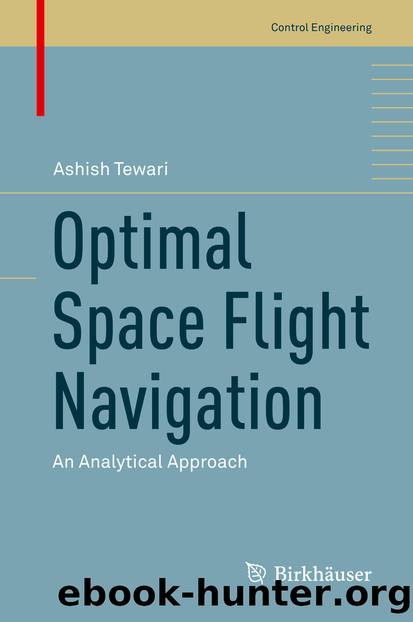Optimal Space Flight Navigation by Ashish Tewari

Author:Ashish Tewari
Language: eng
Format: epub
ISBN: 9783030037895
Publisher: Springer International Publishing
(4.115)
where is the constant solution to
(4.116)
Referring to the orbital plant dynamics, the constant gain approximation consists of neglecting the variation in the nominal orbital radius with time, r n(t) ≈ r n(0).
4.8 Basic Guidance with Continuous Inputs
Either positioning the spacecraft relative to a given point in an orbit or changing its position and velocity to achieve a new orbit, both require an ability to move the vehicle relative to a desired terminal state. Hence the term guidance refers to the process of changing the flight path in order to meet desired terminal conditions. Guiding a space vehicle involves modifying the translational motion of its center of mass (i.e., orbital mechanics) by the application of acceleration inputs. These inputs can be applied either impulsively (as seen in Chap. 3) or continuously. In a spacecraft—as in any other vehicle—there are two broad ways of applying continuous acceleration inputs for guidance purposes: (a) varying the flight direction via acceleration inputs applied normal to the flight path, and (b) changing the kinetic energy via tangential inputs. The adjectives “tangential” and “normal” refer to the instantaneous flight direction, which could be changing continuously. Method (a) is referred to as maneuvering (or steering) whereas method (b) is called energy control . Each of the two methods require a guidance logic whose derivation can be carried out by optimal control theory. While it is possible to devise multi-variable control laws for performing both maneuvering and energy control simultaneously, it is much more intuitive to develop guidance techniques for them separately and analytically. Being much simpler than a numerical 2PBVP solution, basic guidance methods have been practically used in even the most challenging missions, such as guiding the landers to the surface of the various planets and the moons, beginning with the Apollo program, as well as in making orbital rendezvous between two (or more) spacecraft.
Guidance for changing the flight direction is referred to as the maneuvering guidance. Here the application of normal acceleration control inputs causes a variation in the flight path, which in turn results in a new orbit. The most common example of maneuvering guidance is for achieving a desired final position from a given current position and velocity, such as in a terminal interception problem. Since the terminal velocity is an unspecified target, the flight energy is not a part of maneuvering, and can be controlled separately as discussed in the previous section.
The dependence of the optimal control input on the ever changing current position makes the maneuvering guidance a time-dependent (or non-autonomous) system. Maneuvering guidance is aimed at intercepting a specific target, which can either be another spacecraft or a specified set of position and velocity coordinates defining a moving point in space. Such an interception requires a continuous reduction in the distance between the target and the maneuvering spacecraft. The acceleration control input is applied normal to the relative velocity vector such that the spacecraft closes in on the target at any given instant, often maintaining a constant relative speed. Let us begin the treatment of guidance laws with a simple motivating method.
Download
This site does not store any files on its server. We only index and link to content provided by other sites. Please contact the content providers to delete copyright contents if any and email us, we'll remove relevant links or contents immediately.
| Aerodynamics | Aircraft Design & Construction |
| Astronautics & Space Flight | Avionics |
| Gas Dynamics | Propulsion Technology |
Whiskies Galore by Ian Buxton(41489)
Introduction to Aircraft Design (Cambridge Aerospace Series) by John P. Fielding(32857)
Small Unmanned Fixed-wing Aircraft Design by Andrew J. Keane Andras Sobester James P. Scanlan & András Sóbester & James P. Scanlan(32534)
Craft Beer for the Homebrewer by Michael Agnew(17902)
Turbulence by E. J. Noyes(7660)
The Complete Stick Figure Physics Tutorials by Allen Sarah(7097)
Kaplan MCAT General Chemistry Review by Kaplan(6548)
The Thirst by Nesbo Jo(6406)
Bad Blood by John Carreyrou(6245)
Modelling of Convective Heat and Mass Transfer in Rotating Flows by Igor V. Shevchuk(6202)
Learning SQL by Alan Beaulieu(5995)
Weapons of Math Destruction by Cathy O'Neil(5779)
Man-made Catastrophes and Risk Information Concealment by Dmitry Chernov & Didier Sornette(5593)
Digital Minimalism by Cal Newport;(5325)
Life 3.0: Being Human in the Age of Artificial Intelligence by Tegmark Max(5147)
iGen by Jean M. Twenge(5125)
Secrets of Antigravity Propulsion: Tesla, UFOs, and Classified Aerospace Technology by Ph.D. Paul A. Laviolette(4862)
Design of Trajectory Optimization Approach for Space Maneuver Vehicle Skip Entry Problems by Runqi Chai & Al Savvaris & Antonios Tsourdos & Senchun Chai(4807)
Electronic Devices & Circuits by Jacob Millman & Christos C. Halkias(4698)
